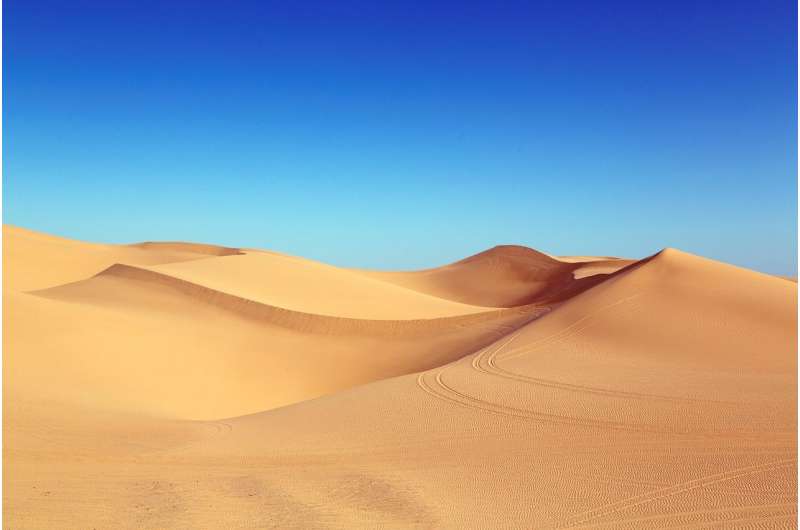A new model could help stall shifting sand dunes, protecting infrastructure and ecosystems

Cambridge scientists have used downscaled laboratory models to show how sand dunes move through a landscape, revealing the conditions that determine whether they will pass through hurdles in their path—like pipelines or walls—or get stopped in their tracks.
The team's experiment—which featured mock-up obstacles of varying size and shape—shows that large obstacles are the most effective at halting the migration of a dune, especially when they are ridge-shaped, like a wall, rather than smooth and cylindrical, like a pipeline.
The model, published in Physical Review Fluids, is the first to describe interactions between sand dunes and obstacles.
By analyzing how currents are deflected in the presence of an obstacle, they were also able to develop an efficient, data-driven tool which aims to forecast how a dune will interact with its surroundings.
The research could help in the design of more effective barriers that can, for instance, stop sand dunes invading agricultural land. It could also be used to protect sand dunes and their unique ecosystems from damage.
"Moving sand dunes impact people and their livelihoods directly; across the world and in a range of environments," said lead author Karol Bacik, who conducted the experiments as a Ph.D. student in the Cambridge's Department of Applied Mathematics and Theoretical Physics (DAMTP). "By revealing the physics behind dune-obstacle interactions, this work gives us the guiding principles we need to divert or halt dunes—mitigating damage."
As deserts continue to expand, sand dunes pose an increasing risk to the built environment: swallowing up roads and houses whole as they engulf the land. In a similar way, dunes on the seabed can block shipping routes and even compromise the safety of underwater cables and pipelines.
But in certain locations, rather than stopping the sand dune moving, it can be preferable for a dune to move through an obstacle as quickly as possible. Take pipelines, for instance, which can be damaged if buried under the weight of a stationary dune for too long.
Bacik's work shows how obstacles of varying design should be selected to fit the desired outcome, "If you want the dune the pass, make the obstacle as smooth and rounded as possible—if you want to halt it, make it as sharp as possible," said Bacik.
The research is one of a series of experiments Nathalie Vriend—who is based jointly at Cambridge's BP Institute for Multiphase Flow, the Department of Earth Sciences and DAMTP—has been leading experiments to understand why sand dunes move like they do. "Sand is fascinating: pour some from your hand and it flows like a liquid….then, when it lands, it makes a solid heap," she said. "But toss it into the air and it blows along like a gas. It's ability to morph between states like this makes it a real challenge to model how sand moves."
The team made a ring-shaped tank to contain their sand dunes, which can travel in circuits, almost like a 'merry-go-round'. By submerging the dunes in water, and disturbing the flow with paddles, they were able to reconstruct how the dunes are moved by water currents. They then put obstacles of varying size and shape in the path of the moving dunes to observe their effect.
"We can see evidence of sand dunes moving right in front of us, but what's fascinating is their movement is all down to the hidden flow of water currents or wind patterns," said Bacik, "You can't see the curling tails of turbulence until you use a visualization technique…and its only then, once you have done a fluid analysis, that you can really understand why sand dunes move like they do."
The researchers' ultimate goal is to model sand dune movements in more complex and realistic, three-dimensional, landscapes in addition to exploring the wind-blown dunes found in deserts. Ideally, they would like to be able to pinpoint a location on a map, input information on weather, air or water currents, and predict whether a dune would pass over a specific obstacle. Although these numerical simulations would be more complex, their new experiments serve as an important validation benchmark for continued exploration.
More information: Karol A. Bacik et al, Dynamics of migrating sand dunes interacting with obstacles, Physical Review Fluids (2021). DOI: 10.1103/PhysRevFluids.00.004300
Provided by University of Cambridge




















